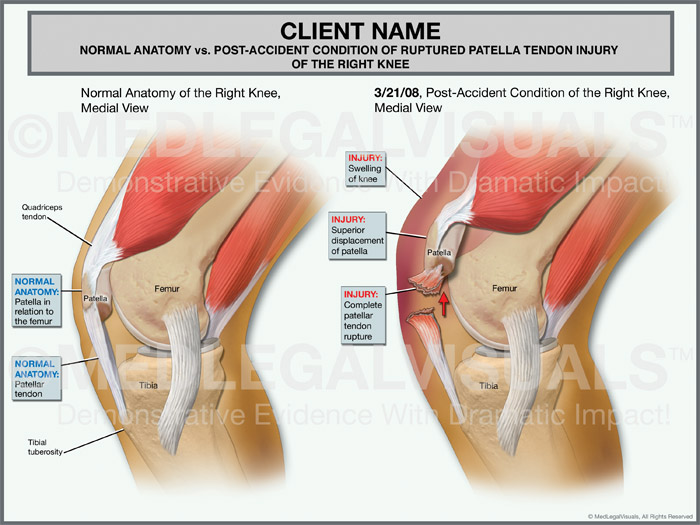Images are provided by:Med Legal Visuals
Though patellar tendon injuries are often associated with physical activities like running and jumping, they are one of the most common lower-body injuries that result from car accidents. They can be bad, or they can be worse.
The kneecap (patella) is connected to the top of the shin bone (tibia) by a muscle called the patellar tendon. The patellar tendon can become injured when a forceful blow or impact directly hits one’s knee. The muscle is generally very strong, but car accidents, when they hit in a certain area, can provide more than enough force to partially or completely tear the tendon.
Partial tears occur when some strands of the tendon are torn but the tendon is still in place, holding the kneecap to the shin. Complete tears occur when the tendon is fully ripped from the tibia, often causing the kneecap to be pulled up toward the thigh by the remaining quadriceps muscle it is attached to. Both injuries are serious and require medical attention.
An injury to the patellar tendon is often accompanied by a “tearing or popping sensation,” and symptoms can include bruising, tenderness, cramping, and an inability to straighten your knee, according to the American Academy of Orthopedic Surgeons website.
X-rays and/or an MRI scan are often used to determine the severity of the injury. Partial tears can be treated without surgery. The victim of a partial tear may have to wear a knee brace for 3-6 weeks and use crutches to help the muscle heal, and then gently wean it back into motion. Physical therapy and exercises help the muscle to gradually regain strength and motion. Complete tears require surgery to reattach the kneecap to the patellar tendon. Surgeons will usually stich the torn tendon muscle back through small “drill holes” at the top of the kneecap, resetting the muscle to the bone, while trying to match the same tension and position as the uninjured kneecap, the AAOS website explains.
Do not delay seeking medical attention for this type of injury as the tendon can shorten the longer you wait, and may require the surgeon to extend the tendon by adding outside tissue.
Surgical treatments can take 6 months or longer to heal from.
Though patellar tendon injuries are always an unpleasant experience, most people would rather hurt themselves playing sports or exercising than doing so in a car accident. There are certain cars that will protect your lower body better than others in front-end crashes. When the outer edge of a vehicle’s front end is struck, say by a pole or another car, “crash forces go directly into the front wheel, suspension system and firewall,” according to the Insurance Institute for Highway Safety (IIHS). “It is not uncommon for the wheel to be forced rearward into the footwell, contributing to even more intrusion in the occupant compartment and resulting in serious leg and foot injuries.” The IIHS made “small overlap frontal test” a standard part of their vehicle safety tests in 2014 to improve the outcomes of crashes like this.
Minicars did not do well in the small overlap test. Only the Chevy Spark was able to earn an “acceptable” rating in the category. Do your patellar tendons a favor and look through this IIHS Top Safety Pick list to see which new cars will protect your legs the best.
Don’t forget that if you or a loved one were involved in an auto accident, we have a wide selection of free legal resources to help you decide how to choose the best lawyer for your case.














Jason at premier law group is truly an outstanding individual. Our particular case was not something that their firm usually sees but they were more than willing to help us and give us all of the information they had available. I can't recommend them enough.